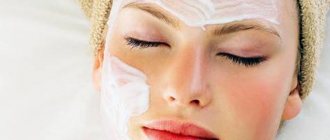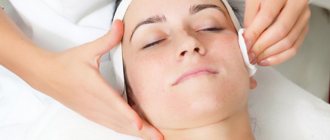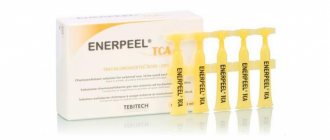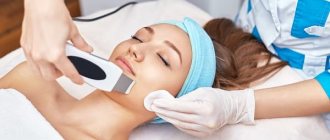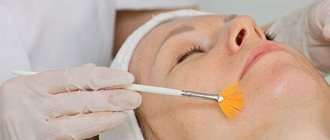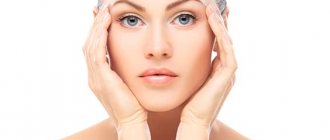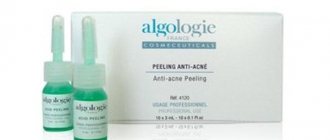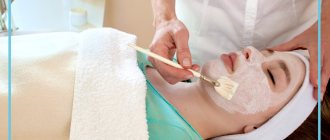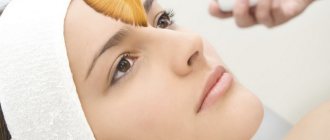What is Azelaic acid and how does it work?
AA is a carboxylic acid that is formed naturally on normal skin during lipid metabolism and is found in small quantities in the human body. When applied to the skin, AK preparations easily penetrate the epidermis and dermis, with up to 4% of the total dose entering the systemic circulation.
Functions performed by AK on the skin
- Anti-inflammatory effect – stops the inflammatory process.
- Antioxidant effect – binds free radicals.
- Antimicrobial effect (bactericidal) – effective against gram-positive and gram-negative microorganisms, suppresses the transition of C. Acnes to a pathogenic form, retains the skin microbiome (bacterial flora), thereby reducing the load on the immune system.
- Keratolytic effect - eliminates hyperkeratosis of the mouths of the sebaceous glands follicles.
- Normalizes the process of differentiation of epidermal cells.
- Lightening effect - suppresses melanin synthesis by inhibiting the enzyme tyrosinase.
- Antiandrogenic effect - suppresses the synthesis of type I 5α-reductase, which leads to a decrease in the content of dehydrotestosterone in sebocytes, thereby normalizing the processes of keratinization and sebum secretion.
According to the latest data, AK has an antifungal effect against fungi of the genus Pityrosporum ovale and Candida albicans, which are resistant to antibiotics. Microorganisms do not develop resistance to AK itself even after prolonged exposure.
Acne and rosacea are the most common diseases in the practice of dermatologists and cosmetologists. Diagnosis and choice of treatment algorithm present certain difficulties. The high prevalence, chronic relapsing course, severe psycho-emotional disorders, decreased quality of life of patients with acne and rosacea explain the importance of the task of further improving therapy.
Rosacea
The mechanisms that cause the pathological process in rosacea and acne are not fully understood. Rosacea is a chronic skin disease with areas of redness (mainly in the facial area), the formation of pustules and other rashes. The RISE study, conducted in Russia and Germany and including 3013 and 3052 individuals aged 18–65 years, respectively, identified 5% of patients with rosacea in Russia and 12% in Germany [1]. Among patients with rosacea in both countries, women accounted for 75% (average age 40 years), patients were characterized by fair skin (phototypes II and III on the Fitzpatrick scale) [2]. The prevalence of rosacea correlates with skin phototype and general solar activity in the region of residence, which demonstrates the key role of insolation in provoking the disease [3].
Rosacea is classified into four subtypes and one disease variant:
- erythematotelangiectatic (subtype 1);
— papulopustular (subtype 2);
— phymatous (subtype 3);
- ophthalmic rosacea (subtype 4).
There is a variant of granulomatous rosacea, which is more often registered in people with skin phototypes IV and V. In the RISE study, the main subtype was erythematotelangiectatic (subtype 1), which is confirmed by the results of other studies [4, 5].
Rosacea is characterized by the formation of erythema, edema, and a sensation of burning pain. Histologically, dilated blood vessels without signs of neoangiogenesis are detected. In all forms of the disease, accumulation of mast cells and fibroblasts is observed in the affected area, which indicates the synthesis of chemokines and growth factors that cause migration of these cells into the dermis. In the erythematous form (the most common), the number of sensory neurons directly involved in the pathogenesis of the disease is increased. Since rosacea causes vasodilation, leading to local enrichment of tissues with nutrients, this may be the cause of a secondary infection. In some patients, Demodex mites are found in areas of inflammation. The role of mites in the pathogenesis of rosacea remains controversial. It has been shown that rosacea is associated with pathology of the digestive tract, dysfunction of the endocrine system, changes in the pilosebaceous apparatus and connective tissue of the dermis, immune disorders, psychovegetative disorders, and an increase in the number of microorganisms on the skin [6-9]. The cause of somatic diseases can be increased vascular reactivity not only of the skin, but also of other organs.
Acne is a skin disease characterized by hyperplasia of the sebaceous glands, hyperkeratosis and the formation of comedones - sebaceous-horny plugs in the ducts of the sebaceous glands with partial or complete blockage. The disease most often begins in puberty with adrenarche and is characterized by increased production of sebum, which leads to a decrease in local immunity in the sebaceous glands and the addition of a secondary infection, most often caused by Propionibacterium acne s
- anaerobic gram-positive bacterium.
Bacteria P.
_
acnes
uses fatty acids in sebum, including propionic acid, which stimulates the proliferation of the microorganism. With excess production, the composition of sebum changes, the level of linoleic acids decreases, the level of squalene and peroxide lipids increases, and the level of saturated fats increases [3, 10, 11]. Comedones develop in areas rich in sebaceous glands: on the face (99%), back (60%) and chest (15%) [12].
Unlike rosacea, acne is a common skin disease, accounting for 20–30% of all cases of dermatological diseases [12]. The progressive course of acne, tolerance to therapy, and cosmetic defects reduce the quality of life of patients, cause significant discomfort and psycho-emotional disorders, mainly of a depressive nature [13, 14].
The pathogenesis of acne is associated with increased sebum production and an imbalance of lipids in the secretions of the sebaceous glands. Colonization of P. acnes
is a consequence of a decrease in local immunity and an additional stimulus for its activation.
Normally, P. acnes
constitutes up to 50% of microorganisms colonizing the skin with a large number of sebaceous glands and only 5-10% in other areas of the body [15]. The inflammatory process in the area of the pilosebaceous follicle leads to the development of follicular hyperkeratosis and obstruction of the ducts of the sebaceous glands (microcomedone, comedo).
Common Characteristics of Rosacea and Acne
Analysis of gene polymorphism shows the presence of a genetic predisposition to both diseases in at least half of the patients [16–25]. However, the prevalence of acne indicates that the pathogenesis of the disease is associated with the polymorphism of many genes [3].
Common to both diseases is the predominant localization of the process on the skin of the face. Innate immunity takes an active part in the effector phase of rosacea and acne. The stratum corneum of the skin represents the main barrier to pathogens. Of great importance is maintaining a certain acidity of the skin, the so-called “Marchionini acid mantle”, consisting of components of sweat and sebaceous secretions, which includes lactic acid, free fatty acids, urocanic acid and other components that provide the skin with an acidic pH (5.3– 5.6). It has been shown that in acne, the pH of the skin increases, which supports the proliferation of the main commensals in the sebum - the P
.
acnes
and, as a result, promotes the activation of innate immune mechanisms, in particular the synthesis of antimicrobial peptides (AMPs) by the cells lining the sweat and sebaceous glands [26].
AMPs are low molecular weight compounds consisting of amino acids (peptides) and have antimicrobial activity against a wide range of microorganisms: gram-negative and gram-positive bacteria, viruses, protozoa and fungi [27]. AMPs are the first line of defense and are constitutionally present; their levels increase with inflammation or injury. AMPs include α-, β- and θ-defensins, cathelicidins, S100 proteins, and RNases.
In the pathogenesis of rosacea, the role of antimicrobial peptides, the synthesis of which is carried out by neutrophils, mast cells, and macrophages located in the perivascular space, has been shown [28–32]. Activation of mast cells results from vasodilation and is associated with the antimicrobial and reparative functions of these cells. A special role in the pathogenesis of rosacea is played by cathelicidin, from which, as a result of proteolytic hydrolysis in cells, the peptide LL-37 is formed, which plays a major role in the pathogenesis of rosacea [32].
The innate immune system is also involved in the development of acne. Changing the amount and composition of sebum activates the immune system long before comedones appear [33]. The main AMPs involved in the pathogenesis of acne are β-defensins 1 and 2 [34–36]. Just like with rosacea, the nerve endings of skin vessels are involved in the pathogenesis of acne; the role of increased production of the neuropeptide corticotropin-releasing hormone and increased expression of the melanocortin 1 receptor has been proven [37-39]. In acne, activation of toll-like receptors on cells of the innate system is also shown [40].
Thus, with acne and rosacea, for various reasons, the normal homeostasis of the facial skin is disrupted, which causes activation of innate immunity, disruption of skin acidity, and the addition of a specific infection, which additionally stimulates innate immunity.
Azelaic acid in the treatment of acne and rosacea
One of the widely used topical agents in dermatology and cosmetology is azelaic acid (AA). AA is the end product of linoleic acid oxidation, which is formed naturally in normal skin. After application to the skin, AK preparations easily penetrate the epidermis and dermis. Up to 4% of the total dose enters the systemic circulation. AK restores the acidity of the skin, which in itself has a healing effect. Thus, other acids, such as retinoic, acetylsalicylic, and fruit acids, also have a therapeutic effect [41, 42]. In addition to influencing skin pH, AA, in particular, suppresses the synthesis of reactive oxygen species by neutrophils and enhances the expression of the p 53
in sebocytes, which leads to their death; has a local antiandrogenic effect by reducing the activity of type I 5a-reductase and, accordingly, reduces the concentration of dihydrotestosterone in sebocytes, thereby normalizing the processes of keratinization and sebum secretion [43, 44]. AA has been shown to have an antioxidant effect, reduce the production of superoxide and hydroxyl radicals, and reduce inflammation [45]. With long-term use of AA, normalization of the differentiation process of epidermal cells is observed, and post-inflammatory hyperpigmentation decreases [46].
According to clinical studies [47], AK is effective both as monotherapy and in combination with antibiotics. AK in the form of monotherapy can be recommended for the treatment of comedonal acne, mild to moderate papulopustular acne, and for maintenance therapy [48, 49]. For severe papulopustular and conglobate acne, a combination of AK with systemic antibiotics is recommended. Monotherapy with AK, benzoyl peroxide (BPO) and topical retinoids has comparable effects [48]. Thus, in the work of H. Gollnick et al. [48] presented data from two clinical studies that included 351 and 229 acne patients on the comparative effectiveness of 15% AA gel with 5% BPO gel and 1% clindamycin gel. The authors showed that the use of drugs for 4 weeks provided equal 70% effectiveness in reducing the number of inflammatory elements in all groups. Side effects in the form of local burning and irritation were more pronounced in the group of patients using BPO than in the group of patients using AK [48]. Minimal side effects were observed in the group of patients treated with clindamycin gel. In a study by G. Stinco et al. [49] studied the sebostatic effect of AA, adapalene and BPO in the treatment of 65 patients with moderate acne. Using sebumetry, the level of sebum secretion in the facial area was assessed. All drugs used had a comparable therapeutic effect, but only AA and BPO provided a decrease in sebum production. According to patients, AA is better tolerated than topical retinoids or BPO. In cosmetology, AK is actively used in the form of peeling for problematic, porous skin and for the treatment of post-inflammatory hyperpigmentation. In Russian recommendations for the management of patients with acne, AK (25% cream or 15% gel) is indicated as a first-line drug for monotherapy of comedonal and inflammatory acne. For the treatment of acne in women, retinoids in combination with AA are recommended as basic therapy.
For external treatment of type 2 rosacea (papulopustular), the Russian Society of Dermatovenereologists and Cosmetologists, as well as the American Acne and Rosacea Society, recommend metronidazole, AK, clindamycin and other drugs [50, 51]. Data from a number of clinical studies have shown the effectiveness of rosacea monotherapy with 15% AA gel [52–55]. A 2016 meta-analysis, which included 57 randomized clinical trials with a total of 13,630 participants (patients with rosacea subtypes 1 and 2), compared the effectiveness of topical drugs metronidazole, AA, ivermectin, brimonidine and others, as well as systemic antibiotics or their combinations with topical retinoids. The best results were shown with the use of topical metronidazole and AA [56, 57]. During long-term therapy, to maintain control of papulopustular rosacea, the use of AC is recommended as maintenance therapy for up to 6 months [58].
Micronization
AK is slightly soluble in aqueous solutions; therefore, the effective concentration is proportional to the dissolved fraction of AK. To increase the effectiveness of poorly soluble substances, micronization and nanonization of drugs are used. Nanized and micronized forms of drugs can increase the bioavailability, solubility and stability of drugs, and improve the penetration of colloids through tissue barriers and cell membranes. From the point of view of biopharmaceuticals, the nanosize is ideal, but from the point of view of drug production, obtaining nanoparticles is problematic, which is associated with the existing methods for their production. For these reasons, micronization of poorly soluble drugs is the most suitable solution. Micronization may involve grinding the active substance using various methods and then introducing it into various carriers (hydrogels, creams, foams).
Russian doctors today have several drugs containing AK in their arsenal, one of them is a micronized drug - 15% Azelik
(JSC Akrikhin).
To increase the effectiveness of high concentrations of AA, it is necessary to increase the solubility of the acid in the gel base. Gel Azelik
15% (JSC Akrikhin, Russia) is the only domestic micronized preparation, the particle size of AA is less than 100 μm [59].
The micronized form ensures easy penetration of the drug through the stratum corneum of the skin, which contributes to the antibacterial, keratolytic and depigmenting effects of AK [59]. This allows Azelik
the drug of choice for the treatment of acne, as well as the first-line drug in the treatment of papulopustular rosacea.
The authors declare no conflict of interest.
1e-mail 2e-mail
Peeling with azelaic acid
Study
A study was conducted on the effect of AA, which is part of the surface peeling, on the secretion of sebum in various areas of the face in women.
Research data:
- 11 women aged 49-71 years
- Measuring sebum levels with a sebum meter
- Peeling course – 5 procedures with an interval of 2 weeks
Results:
Decreased sebum production
even out skin tone,
narrowing of pores,
reduction of inflammatory elements of acne.
How does AK work as part of a peeling?
- Has a sebum-regulating effect;
- Evens out skin tone;
- Works against acne and prevents the appearance of new rashes;
- Increases skin tone and elasticity;
- Evens out skin texture.
Summary
Peeling with azelaic acid is ideal for adult skin prone to inflammatory acne and rosacea; Peeling is effective for enlarged pores and oily skin; Azelaine peeling works against age spots.
